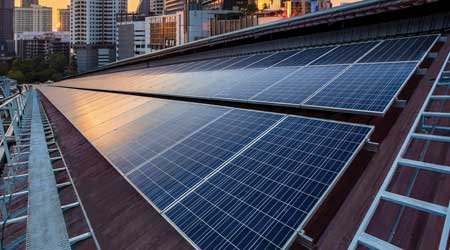It's Renewable Energy's Time to Shine
All signs point to a forthcoming boon for onsite renewable energy, especially solar. Here's what you need to know.
Renewable energy is poised for another breakout. While the last few years slowed adoption of renewable energy technology in the United States, the overall trend is a steady uptake across the board, including in commercial facilities. The Solar Energy Industries Association (SEIA) is calling the 2020s the Solar+ Decade, with a goal of generating 20 percent of all U.S. power from solar by 2030.
Still there are numerous complications to navigate before commercial renewable energy projects pencil out. These include everything from physical limitations at a site, a local utility or regulatory landscape hostile to renewables, access to capital, and expectations for return on investment. Even with these complications, some form of renewable energy is within the reach of just about any facility manager in the country, but the path to renewable energy is different for each facility.
Solar makes sense
Renewable energy generation encompasses several technologies — solar, wind, hydro, geothermal, and others. However, in the context of commercial facilities in the United States, renewable energy seems to be synonymous with photovoltaics. Perhaps one reason is that solar makes sense for almost any facility. In fact, solar power generation can be the least expensive way to generate electricity ever, according to the International Energy Agency’s World Energy Outlook 2020. Solar energy generation in the United States has grown at an annual rate of 49 percent since 2010, with more than 85 gigawatts (GW) of solar capacity installed nationwide by the end of 2019, according to SEIA. However, the majority of those installations are residential, followed up by industrial, and then commercial.
Given the right parameters, plugging into on-site solar generation can be relatively simple. The easiest way to do on-site renewable energy is to attach to the grid with a net-metered agreement, some solar panels, and an inverter, says Joshua Pearce, professor of electrical and computer engineering at Michigan Technological University, and director of the Michigan Tech Open Sustainability Technology Lab.
"It's a straightforward system design. The real beauty of PV is that it's like the ultimate capital asset," says Pearce. After the initial investment, you pretty much know what your energy costs are going to be for the next two decades. "They're guaranteed to work for 20 to 25 years under warranty. And I can pretty much guarantee you your panels will continue to work after that. They might not be at the same rated power as Day 1, but they're still producing 80 percent of what they're rated."
Anyone who looked at solar a decade ago can be forgiven for thinking that it was not economic, he says. "But today, it's such a slam dunk more or less everywhere that people should be looking at it as a way to save money," Pearce says. "It's basically a no-brainer, but there are limitations." Building infrastructure or available space are two such limitations.
In Los Angeles County, Minh Le, general manager for energy and environmental services for the County of Los Angeles internal services department, recently finished adding 4.5 MW of solar generation on four county sites, including a hospital and three headquarters facilities for county services. The installations are a combination of rooftop solar and carport solar. While that is a significant amount of generation, Le keeps it in perspective of the county's overall load.
"We have about a non-coincident peak load of 100 MW, so adding 4.5 MW is a relatively small amount to offset the county's utility cost," he says.
Looking to expand the county's solar generation, Le has bids out for a major installation at a correctional facility campus which would also include a large amount of energy storage (on the order of 20 MWh or more) to provide backup to the site but also improve grid integration for that local region, he says. There isn't a lot of energy storage in the county building portfolio in general, but the correctional facility campus accesses a substation and could send a large amount of power back to the grid from in front of the meter, either from solar generation or battery, he says.
Le says it makes a lot of sense to put up rooftop solar if the roof is in good condition and newer with lots of clear space. However, many of his county's buildings have older rooftops. Considering installations on carports is a good option for his portfolio. It's more expensive than rooftop solar, but in sunny Los Angeles the shade the panels provide is appreciated by facility users.
One way Le has had success funding on-site solar installations is through power purchase agreements, which require no upfront capital.
"But there's a narrow window where those transactions make financial sense," Le says. In some of his territory, power purchase agreements are not allowed, and in other areas local utility rates make installing solar unattractive. "Those have to be studied extensively to pencil out," he says. "These are not pet projects to make the buildings look green. I have to make sure that the bottom line is a savings for the county."
Related Topics:














